Here in the American Southwest, the siesta is a time to kick back and relax between the early morning vigors of work and the late evening rigors of revelry. For roses we approach siesta season. By mid June, roses in my garden are typically starting their midsummer break, here in the mountains of Arizona. It is a seasonal rhythm I learned first when gardening roses in Texas decades ago. Five days ago I was tempted to believe this year was going to be an exception, that the roses would just keep on going. A recent record-breaking heat spell has meant otherwise. Most roses are now approaching that moment.
For each rose there is a slightly different story. Neil Diamond never quite got fully open before its flower dried out (Below, Far Left). This was a brand new rose this year, and the root system is still getting established. The same thing happened to Big Purple for the same reason. Jubilee Celebration (Below, Mid Left) is entering its third growing season in the gulch, and its roses are opening fully, aging, and then drying out.

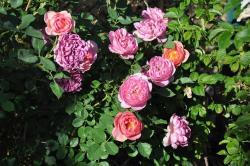
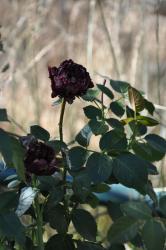
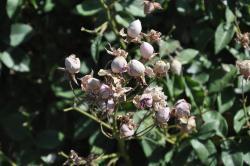
I am pleasantly surprised by the success of the roses in the gulch. Even though they get a little shade it does not seem to slow them from blooming. The Darcy Bussell with the most sunlight blooms most vigorously, but its flowers fade fastest, too. Most of these roses, like Darcy Bussell, are David Austin roses. They are bred to do well in climates generally cooler and a little more humid than the mountains of Arizona in June. A good portion of these cultivars bear flowers with thin petals which, in hot dry weather, dry out fast. My guess is that in most normal summers this problem is not so severe as it would be in, say, California's central valley. Or in Phoenix, for that matter. But this year the problem was exascerbated by a more severe problem with thrips.
Baronne Prevost's roses simply do not open in spring, here. they crisp up long before. Evidently they are thin petals, fragrant, and early. It is only in fall after a good monsoon that the rose makes open blossoms. Other roses that crisped up before even opening include Red Eden (Above, Mid Right), Marchioness of Londonderry, The King's Rubies, Blush Noisette (Above Far Right) and a kissing cousin, Joan of Arc. We imagine that thrips figured as part of the reason for several of these roses. The thrips problem was most evident in mid May on fragrant roses. On roses that are not fragrant and ones that set buds three weeks later - after the thrips had been mostly brought under control by predators - the problem nearly totally gone. We can say this with some confidence because Abraham Darby in the beginning of June was covered with crispy flowers, but it now has normal ones.
Abe Darby makes an interesting study of the problem. Roses made much before 24 May 17 (Below, Left) were a total loss, being crispy long before they opened. As the thrips problem came under control they began to reach full maturity, as is seen in the third photo (Below Right) taken 15 Jun 17.
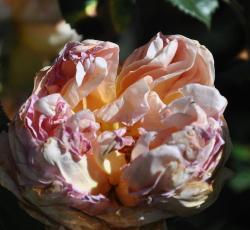


That said, the crispy dried rose issue is not completely gone. Even once the thrips are under control we observe some roses that have crisped within a day: William Shakespeare 2000, and Falstaff. The flowers on Prosperity and Chevy Chase crisped up pretty convincingly, but these roses had been in bloom for something approaching three weeks before this happened. Which roses have not gotten crispy? The hybrid tea roses that survived being pruned severely this spring, Grande Dame and Fire Fighter are just now putting out their first blooms of the season. These are not turning crispy, yet. Interestingly, these are HT roses known for their fragrance, so just as Abe Darby does, they should be subject to the problem while it exists. Looping never crisped; as beautiful as it is it does not have a fragrance to match. Selfridges, though early and fragrant only got a touch of damage at the tips of the petals.
Most of the roses in the gulch, even the David Austin roses, are not getting crispy - at least not in an untimely way. This includes Darcy Bussell, Jubilee Celebration, Mary Rose, Princess AnneLady of Shallott, Teasing Georgia, Pomponella FT, South Africa, and Day Breaker. Graham Thomas, after a glorious bloom is taking a break. Ascot is planted in two locations. In the one that gets just six hours of sunlight, its flowers are not crisping up. Those on the one getting a full twelve hours of AZ sunlight are crisping a bit. Looping's roses faded completely before crisping, a process that took maybe three days. One might argue that the problem is that the roses are not getting quite enough water. Surely this is a factor. The multifloras like Conrad Heinrich Soth and Rosy Cushion were untouched by thrips. Most of the DA roses in the gulch get enough shade that their bloom time was delayed by a week or two, so the thrips problem was under control. Any crispiness is going to be thanks to moisture problems in the rose petals.
At this moment, the star of the garden is Colorific (Below, Far Left). It set one beautiful rose about two weeks ago. And each third or fourth day just as the predecessors are dying, it produces half again as many new ones. Planted nearby, Darcy Bussell (Below, Mid Left) produces deep purple blooms that fade to rosy mauve as they age. Falstaff (Below Mid Right), on the other hand, produces new flowers that start out almost raspberry red and darken toward purple as they age and crisp in the hot sunlight. It's a process that completes in a day or two for this cultivar. Entering its third year in the garden is Teasing Georgia (Below, Far Right), which seems to be providing fresh surprises daily. It seems to be sending up new canes every third week or so, a pace it cannot keep up for long in this heat. And each new cane produces great masses of pale yellow flowers that fade to cream in our bright sunlight.
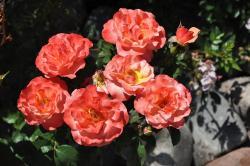



Some of the rose blossoms prove very durable. Gemini may be the best example. Below are shots (Left) of the exact same rose taken one day apart. The poor plant has been suffering in my garden for three years, not growing above knee height. But thanks to a little extra water this season and some extra attention to the gopher problem, it is blooming well. This particular blossom is still on the plant a week later. It has faded to the point of ugliness, but it is not crispy yet. I had expected something like this from Liebeszauber (Love's Magic, Mid Right), but the poor thing crisped up in two day's time. Rainbow Sorbet (Below, Far Right) usually has no problem with crispy edges, but it is lightly touched by the problem this year. Once again, curiously, a photo I took of this rose to demonstrate how ugly it looks this year seems to undermine that point completely.
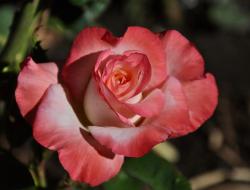
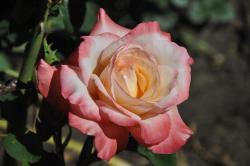

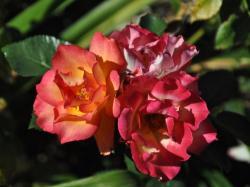
As suggested earlier this is the time of the summer when attention begins to pass from the rose to the daylily. Since daylilies offer somewhat less variation in terms of plant performance, we have little to offer but pictures. With apologies to daylily experts around the world we will mention that our yellows include Mary Todd, Aztek Gold, and Hyperion, and our oranges include Rocket City, and Alabama Jubilee. The photos below may or may not depict one of these cultivars...

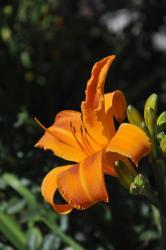
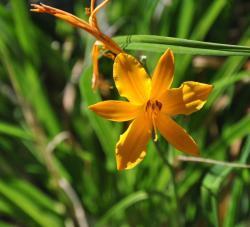
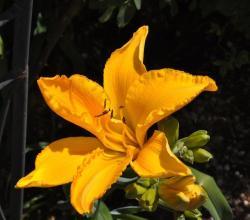
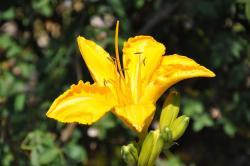
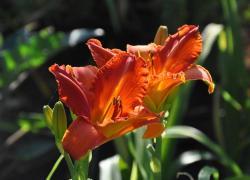
There is no crispnes here. Daylily flowers have the grace to disappear when they cease to wow. It's a trick one might wish more roses could learn.
Exceptional beauty, by definitition, is short-lived. This is one of the reasons we are drawn to certain roses and to daylilies. James Mason, which blooms but once a year, and not for a whole two week stretch, was a big hit this year with gardem visitors - people and bees alike. This plant produced several dozen three to four inch flowers like the one below. The bright red would fade in a day, and in two or three the flowers would fall. This photo was taken 21 May 17. Bees are also found of Rosy Cushion, blooming nearly two weeks later.

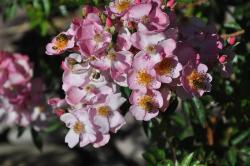
The gulch, an area of the garden where we've planted about twenty roses in an occasional stream bed, hit its stride this season. Prosperity, the hybrid musk rose that has been there for four or five years was covered with great clouds of white roses for nearly three weeks. The David Austin rose Princess Anne, starting its fourth year, mixes with it pretty well. Deeper purple notes were provided by William Shakespeare 2000, LD Braithwaite, and Erinnerung an Brod (not shown). The early blooms of Nicole were evenly spaced over this very nicely branched plant. Later on it would push up stalks with lots of smallish flowers that started looking a little ragged (not pictured)
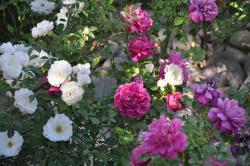
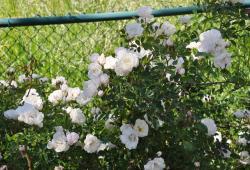
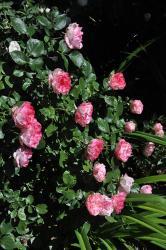
Caramella Fairy Tale rose made roses of the right color for the first time this year. We're unsure whether it was the fact of having a few years to settle in or that it got more water. Either way, we are pleased; and we are pleased to pronounce the rose 'a keeper,' a surprisingly rare declaration that the rose has established, is vigorous and healthy, and that it makes enough blooms to warrant its place in the garden. And that we like where it is in the garden. It joins Malvern Hills, Cherry Parfait, and Ilse Krohn Superior in earning this distinction. (30 May 17)


Some of the companion planting ideas are working. Lady Pamela Carol produces lovely pale yellow blooms that look good with Moonlight yarrow and Blue Hill salvia. Caldwell Pink hovers just above nepeta Walker's Lowe. (31 May 17) At this time of year, the nepeta can be heard humming. The same holds for the salvias Blue Hill, Caradonna, and May Night. (Not pictured.)
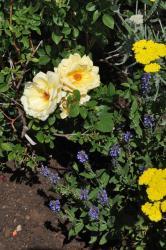
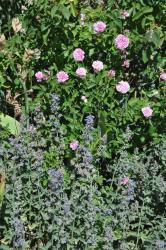
Rainbow Sorbet might be the most photogenic rose out there. On the plant this bunch of spent flowers and buds looked a mess. Somehow, though, the mess translated into an interesting photo. Usually it's the other way around.
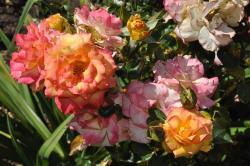
This is one of the few blossoms not ruined by thrips on poor Abe Darby. Teasing Georgia, entering its third growing season is less affected by thrips damage. Chris Evert struggles to get enough water, and the blooms will sometimes be nibbled away; but it does produce pretty flowers.

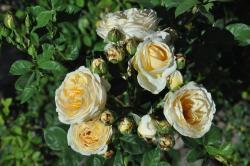
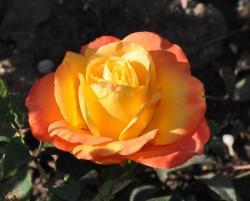
Orfeo, in its fourth year is tall enough to train on a pillar. Not all of its flowers are this color. They can be a softer rosy crimson color. And when they get a bit dry they turn maroon. Looping has its own progression of soft orange sherbet colors. The buds are a bright pastel orange, and they fade just a little toward cream. Colorific's blossoms take two or three days to progress from soft yellow to a vermilion blushed shade of pink.
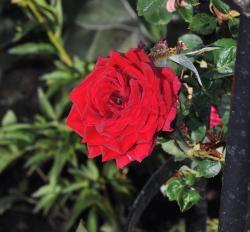
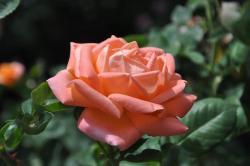
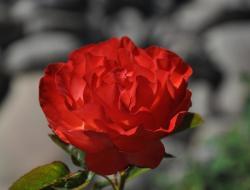
We wish to welcome to the garden a few roses planted this spring: Big Purple and Vavoom. We do hope that as they establish their blossoms will become just a little better, but we are pleased that they are making a good start:
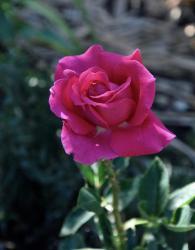

We note in passing that roses that have been severely pruned have certainly had delayed blooming. Grande Dame and all the newly planted roses are good examples. Pruning also made Abe Darby more productive. It took a toll on Crocus Rose. The plant produced a lot of new fresh growth which is good; but it went on to produce lots of tiny flowers in bunches. And they lacked color.
Not everything is roses. A prickly pear cactus flaunts its yellow blossoms, below. This year we had an unusually damp spring, and this prickly pear cactus shows its appreciation with extra flowers. Giving the garden just a little more water this year on top of nature's bounty has been good for the daylilies, too. Alabama Jubilee doles out its first blossom while more established Aztek Gold cranks them out in clouds. An unknown yellow daylily is backed by Showbiz rose.
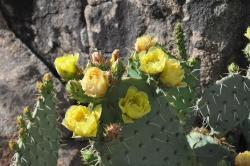


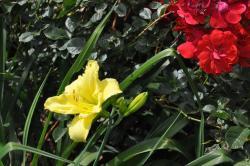
It's a pleasant surprise to find roses and daylilies blooming together, especially when we find their colors to be complementary. The garden is still a wild place, but its colorful blossoms and many rich fragrances they bring make the place a glorious outdoor living space, if only for a few days a year.
It's been an upside-down spring with unseasonably warm weather through the six weeks starting in late February. But its been unseasonably cool in late April and May. Frost has not visited the garden; but forty degree nights have been very common. Sixty degree days coupled with wind have, from time to time, made being in the garden downright unpleasant. Warm weather set the iris and roses in motion for an early bloom season. The coolish weather in May has extended the bloom season of both, lengthening the amount of time any given blossom is on the plant and drawing out the bloom period through the calendar.
One of the lovely consequences of all this is that there is some overlap in the iris and the rose blooming seasons. In many years there is none.
Seen below is the rose Madame Plantier (from ARE in 2013) growing on a fence. It's just now starting to bloom. The dark blue NOID iris (from Shreiner's 2015) have been in bloom for something more than a week and it's unprecedented that they should go on blooming for so long. In both cases, I think a significant measure of their success this year is due to favorable weather, including good spring rains. Both are at an age where they are just hitting their stride.

Another dark purple iris blooms with the rose Zephyrine Drouhin. For the rose, this is the first year of significant bloom since it has only recently reached a height where it is struck by enough sun to make blossoms.

Neither image has the visual impact of an artful close up, but they come close to conveying the sense of the place: how these plants bring some color to surroundings that are otherwise much less interesting.
Somewhat more impressive is the purple iris blooming among California poppies. In this case the photo is better eye candy than the actual garden feature
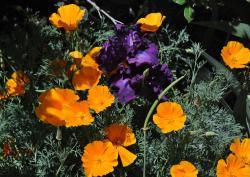
Speaking of eye candy, I've become aware that the Iris can lend themselves to photographic close ups that most roses do not. Here are some experimental photos made as much with the idea of creating a splash of color as of capturing the spirit of the flower.
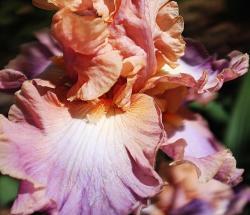
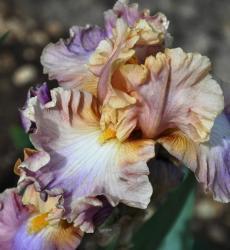
Iris Chasing Rainbows is a veritable chameleon of an iris with the mix of purplish and yellow pigments varying through the petals of the flower and through time. And of course the appearance varies with the time of day and the light spectrum. Whereas the first shot was obviously taken in bright sunlight, the second shot was taken on a rainy day. One could spend a few days a year photographing nothing this cultivar while it is in bloom, and one would end up with a lot of nice shots. Fortunately it's an iris with robust growth. It flowers generously. And the flowers last well. All this makes the task easier.
Sometimes it's sheer bright color that does the trick as in the case of China Dragon shown here. I was working in an iris bed while one of these bloomed and a neighbor stopped and offered to take any off me the next time I divided them. They multiply slowly, IMO, so it may be some time. The fixed focal length camera used to take this was not four inches from the flower, and placement was tricky because the photographer kept stepping into the light of the subject.
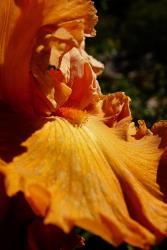
Light has been a monumental problem in photographing Slovak Prince since morning light is unflattering and afternoon light is filtered through nearby treetops. Furthermore, tiny insects feast on the abundant water that inflates the petals as it seeps out. And each one has to be removed by hand in Photoshop.
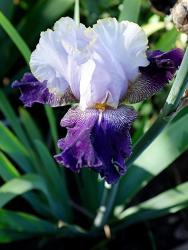
Of course, difficult lighting conditions sometimes lead to unusual shots. The golden light filtering through the iris foliage almost upstages the iris itself.
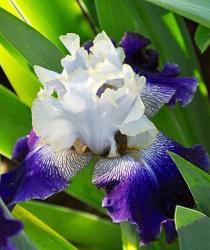
The light is better here, but otherwise it's much the same story with Local Color, taken from the bee's eye view.

Normally the iris close-up works only with a single flower at a time; but on really rare occasions two will come into focus simultaneously.

This NOID iris is a case where visual interest comes close to trumping beauty. That mix of colors on the falls I find highly interesting. Mostly I find it beautiful. In theory that mix of blue and soft violet should go perfectly with the pink standards, yet I'm not 100 percent sure I find it beautiful.
Twenty years ago I planted a brownish plicata iris. It was big, bold, visually striking. As striking as the bloom was, it was not playing well with its neighbors. A friend commented on it, saying she liked it. I, however, was in the middle of trying to decide what to replace it with. I find myself planting many of the most photogenic iris for close-ups far from other plants lest they detract from them. Those boring blue iris that bloom with the earliest pink or pale yellow roses, on the other hand, have proven to be as valuable to the appearance of the spring garden as they are impossible to photograph well. They appear in lots of photos, but none is good enough to appear here.
It reminds me, I planted Spiced Custard iris with the rose Julia Child. It seemd like an inspired choice; but the iris blooms a week too early. And the yellow is not quite strong enough to stand up with the yellow of the rose. A deep blue iris that blooms with Julia Child would be perfect. Or a uniform, deep orange one. Or to be a little cheeky, a strong rose. Something to work on for next year...
It's May 16th and something close to two thirds of the iris are past their prime. By contrast, only the roses Nouveau Monde, Madame Alfred Carriere and Malvern Hills had a significant measure of bloom, and there are many dozens of rose cultivars in the garden. In our next installation we'll give some coverage to roses with early blossoms.
I discovered roses when I lived in Austin, Texas as a young adult. As I wandered the meandering paths of a local nursery I would see the two gallon potted roses from Antique Rose Emporium. The roses weren't in bloom when I bought them, so I would depend on the rather fanciful descriptions of the blossoms. 'Faded Gold kissed lightly with pink' might have been a description of the color of Fortune's Yellow which also had a fanciful alternative name, "Gold of Ophir." Who cannot be bewitched by such things? OK, I understand, most sane people. But it worked for me. I bought a "Gold of Ophir" and trained it on a nearby wooden fence. I think it died for lack of water by week six, but it was not long before I had an established Old Parson's Pink climber trained on one of those cheap wooden arbors one gets for vining plants at Home Depot. It was the first flowering plant of my gardening life and I was very proud of it.
This was in the early 1990s and I was aware of two suppliers. Antique Rose Emporium sold roses in two gallon pots. The roses were well developed having root systems that were usually sufficient to hold together the full two gallons of potting soil they were in. These roses, too, would generally grow pretty quickly to final height. The other sold bare root roses by mail order: two year old roses grafted onto Dr Huey rootstock and graded #1, a specification which, in my recollection translated into a rose with big, heavy canes and thick, long roots. It was a rose that would grow quickly to bloom size in the garden. In both cases one could lose a rose before maturity from some kind of abnormal circumstance: complete failure to give supplemental water in the first year, an attack of blackspot, overspray from nearby use of Roundup, or vicious daily attacks from rabbits and/or deer on the new leaves and shoots. But absent these kinds of failures, success was a high probability event.
A few years after my first successful roses with ARE I started receiving catalogues from Jackson and Perkins. Sun Flare was in my first order from them and it did very well in the warm Texas sun and heavy clay. Roses, in those days seemed easy. I bought a Ballerina rose and in its early days it got a touch of blackspot. But by the middle of year two it had stopped growing so vigorously, hardened off, and seemed immune. A New Dawn rose that I had bought in a gallon pot and planted at a downspout had, in a year grown to over 15 feet in height. Some of the roses I planted were not quite so successful; but I was pleased with most of them.
In the mid nineties I moved from TX to NJ. I planted a lot of roses from Jackson and Perkins. In the first years they all died of blackspot. Maybe there was a touch of neglect involved. Betty Boop really should not have been planted directly under that particular shrub, there was too much shade. Sometimes I did not deliver enough water, and so on. But blackspot played a key role in the demise of nearly all of the failures from ARE, J&P, Pickering, Sam Kedem, and a few other mail order suppliers. I ordered many roses from Antique Rose Emporium. Fantin Latour did well, though it grew very slowly. Early on there was a centifolia with very soft canes that infected the whole garden with blackspot; and removing it made things go a lot better. Sombreuil, Dortmund, and Phyllis Bide did well for while. Errant Roundup killed Sombreuil and Dortmund. Phyllis Bide grew quickly, but collapsed in dry weather. Harrison's Yellow got shovel pruned because I did not understand that it needed five years or so to really fill out. Over the years I planted Playboy, Sally Holmes, New Dawn, City of York, Sea Foam, Olympiad, Knockout, Alba Maxima, Felicity, The Alexandra Rose, Tess of the d’Ubervilles, Mary Rose, Sophy's Rose, Champlain, Don Juan, Mrs John Laing, Queen of Denmark and a few more. With all but a few hybrid tea roses I failed, and black spot was generally in the equation. Ditto floribundas. With essentially every other rose I succeeded and I was very pleased with the garden.
By the time I had lived in NJ for 13 years I had the confidence that I could plant a rose and it would grow -- provided it was not a rose that suffered from blackspot.
Somewhere in that period I tried ordering roses from one company that delivered smaller plants. That’s when I learned that roses can fail not from the neglect of the gardener but from the neglect of the nursery. Every single rose that I ordered from (Unnamed Company) died. And it did it with admirable efficiency. I do not believe one survived three weeks. It did not matter how big a hole I put in the ground. It did not matter what I filled it with. It did not matter what attention I lavished on it. In three weeks the rose was dead. So I removed the supplier from my 'approved vendor' list and did not order from them for more than a decade.
What was different? That vendor sold roses in smallish pots. They might have been bands, although I think the containers were not so tall as bands. The roots of the roses they sold in those little containers, in no case in my memory, touched the plastic walls. The plants were rooted cuttings. Only just. I remember planting a rose called The Fairy - a rose that is reknown in the industry (or should be) as being impossible to kill - that was not yet two inches high. I think it was gone in a week. I lost several dozen such roses in a row, as I recall. And very quickly.
The story, I would find out decades later from people in the know, is that 'you just need to pot them up and grow them on in your greenhouse until they have reached the same two gallon size as those from ARE.' Wait, Wait! What greenhouse are we talking about? Rooted cuttings, indeed, are suitable to be grown to band size when they are grown a greenhouse that is provided with an automated watering system. As they grow in their regularly watered, temperature controlled environments safely out of reach of nibbling animals, they can be progressively repotted until they have grown root systems large enough to bind all the potting soil in a two gallon container. At such a point they should be roughly as viable as the two gallon roses I got from Antique Rose Emporium. At least if they happened to be the same culivars and if they happened to be hardened off correctly, packaged and shipped expeditiously. This is the idea that began to form in my head. Or should have.
Some years after swearing off rooted cuttings from (Unnamed Company whose management has changed twice and whose cultivation techniques have improved more times than that in the intervening decades) I moved to Prescott, AZ. I imagined that this area would have several advantages in terms of rose growing:
1) it is USDA zone 7b whereas my location in NJ was USDA zone 6b,
2) for most of the rose growing season the humidity here hovers around 20 to 30 percent, too low for most fungal infections.
The first two years I gardened here I learned a number of things:
1) roses need more supplemental water than I had imagined
2) roses that were cold hardy in NJ died here of frost damage
3) when it rains in July and August (monsoon season) roses can get fungal diseases
4) gophers, rabbits, and deer covet rose leaves as food and they will go to great lengths to eat these plants, especially when the plants are young.
5) suitable cultivars, of adequate size on arrival, planted at the right time of the year, and given adequate water tended to do very well, indeed.
Living in Arizona meant I was geographically a lot closer to places like Vintage Gardens who had a huge catalogue and I began ordering roses from there. The plants I received looked good much of the time. Or at least they did after I took the pains of explaining to the proprietor that roses less than six inches high were always nibbled to death by rabbits, gophers, ground squirrels and whatnot, but knee-high plants survived these particular garden insults - through the first growing season anyway. In comparison to those plants I received long before in containers that were as small as two inches tall, the VG bands were impressive. In comparison to the two gallon roses from ARE, however, the canes were generally not half as big in diameter. Roses sold as bands had a tiny fraction as much plant material as in a rose properly sold as a two gallon rose. And this made it more prone to damage from all sorts of ordinary, regular, known garden insults.
Over the course of three or four years between 2009 and 2013, VG was in the process of winding down their mail order business and they conducted a number of promotional sales. I was in the process of populating a brand new garden and I bought a lot of roses. There were a few orders early on when I might have ordered six or eight bands at a time. But as the end drew near, I was struck by a kind of panic at the prospect of the full VG catalogue becomming unavailable, and it was common for me to buy two dozen plants in a sale. I think it would be a reasonable estimate to say that I purchased about 150 roses from them in growing seasons 2009 through 2013. My documentation supports the idea that in the last two years alone I ordered 100.
These are the roses that survive today:
1) Nouveau Monde - a marvelous presence in the garden with pink rosette roses much like Pink Pet, but with a habit that is more graceful than any other plant in my garden.
2) Crepe Rose - In the same vein as NM, except with darker flowers produced later in the season. Collapsed last summer presumably due to gopher damage to the roots, seems to be coming back.
3) Looping - In five years it has reached head height and bloomed twice for a total of three blossoms. Lovely, but nothing like a climber.
4) America - In five years it has reached chest height and bloomed three times for a total of three blossoms, each to-die-for beautiful. Lovely, gorgeous, awesome, but nothing like a climber.
5) Centennaire des Lourdes - An open, gangly plant whose flowers are a bit informal. They are a very lovely mix of white and pink. Every year it is on the shovel-prune long list.
6) One unidentified pink floribunda, which is not ankle heigh after five years in the garden. Lovely blossom colors, both blossoms.
7) Agatha Christie - a hybrid tea climber has reached knee-high and has produced its second blossom in its fifth year. Big, long lasting flowers, not especially lovely. Nothing like a climber.
8) Psyche - a very vigorous grower with blossoms that are (putatively) white. Waiting for first blossom.
9) Chatillon Rose - (one of two) No rose is more profoundly proliferous in its spring flush; none in my garden so prone to downy mildew.
10) Heinrich Conrad Soth - it has grown into a bigger plant than we had hoped. Pretty flowers but, overall, unrefined.
11) Dreaming Sires - approaching 24 inches in height, still a little short to qualify as a good climber. Produced a blossom once. It was beautiful, and we hope for more. In its defense, it occupies a tough spot in the garden.
12) Dearest - nears ankle height, currently promising its second blossom ever.
I began planting roses in earnest in 2010 and 2011 and VG was among my suppliers. I started keeping records in the middle of 2012, so I have orders from 2012 and 2013 at which point VG closed to mail-order business. The list of roses I bought from VG which perished in my garden is shown at the end of this article. The list of lost roses extends to 88. So of the 100 for which I have records 12 survived, a survival rate of 12%.
But if we look at which survivors fill the niches for which they were slated, only Chatillon Rose, Nouveau Monde, and Heinrich Conrad Soth actually succeed. That's a success rate of 3%. The other nine roses, though still alive, cannot yet be characterized as successful. Of the three that fill their intended niches, only Nouveau Monde is her to stay. The others are at risk of shovel pruning. So... I bought something like 150 roses from VG of which one is actually something I might do again if I had all the information I have now.
Would I buy Nouveau Monde again? The grassy green foliage of Nouveau Monde strikes me as being the wrong color, but there is not a rose in the garden with a more graceful habit, and few are more generous with its blooms. It blooms early enough in the season for its roses to complement the blue iris that grow at its feet. And it needs less water than just about any other rose in the garden. Probably, the answer is yes, I would buy it again. Would I pay $600 (buy thirty roses to get one success x $20 each) for it? I seriously doubt it. Would I pay $3000 (the only rose out of 150 that's a keeper) for it? If I did, it would certainly not be to have it as a garden plant; I'd have rose breeding in mind.
There are lots of things that affect one’s success with roses, so how do we know this is a problem only of plant size? How do we know that there is not some independent issue associated with cultivation practices?
Lets look at data from two rose suppliers that sell roses both as gallons and as bands for the planting seasons of 2012 and 2013. For Rogue Valley Roses our success with bands was 5 for 16. For Heirloom Roses the success rate was 6 for 26. Again, the data is included at the end of the article. The success rate for bands, then, was 11 for 52, or 21%. This is materially better than the success rate with Vintage Gardens roses; but it’s hard to characterize it as being very good. By comparison, the success rate for gallons from the same suppliers was 4 for 8 or 50%, more than twice as high. For two gallon container roses from ARE the success rate was 19 for 26, or 73%. When planting container roses in the garden size matters.
Before we go much farther we need to mention that the subject of a subsequent work will be the issue of which roses grow well on their own roots and which ones do not. We will be making the argument that most hybrid tea roses and some meaningful portion of floribunda roses simply do not have roots vigorous enough to support the growth and flower production we expect in hybrid tea roses. We will also argue that hybrid tea roses have certain other weaknesses that predispose them to failure in this mountain environment. Roughly one third of the roses in the Vintage Garden order list are hybrid teas. If we were to eliminate them from our considerations, saying that they fail for reasons other than initial plant size, then the success rate with bands for VG goes from 12% to 18% which is not out of line with experience from other vendors.
Long story short: plant a band in your garden; water it three times a week, grow it where it will not get black spot, avoid hybrid tea roses in your orders, and you can expect to lose 80% of your roses, most in the first year. Or I can, at any rate. Change any of these stipulations and your banded roses will disappear faster.
Spend half again as much and buy a gallon rose and your odds go up to about 50%. Nice in theory, but most suppliers who sell bands have gallons in very short supply. Fifty percent a number I can live with; but it's not very good. I have tried, btw, growing roses in containers to a larger size. This did increase my success rate by nearly a factor of two; but I still lost more roses than if I had bought gallons. I still do not have a greenhouse.
So, how does all this compare to roses grown on budded rootstock? In 2013 I lost every single rose from Regan and from Garden Valley Roses. Thirty roses or so. I think it was because they arrived in mid February and early March and they must have suffered from freeze-thaw cycling dozens of times by late April. Most would be stone-cold-dead by mid-April when there were still two or three good frosts left in the season. Mid April is when the David Austin roses arrive. I'm always in a panic because some of my roses have been leafed out for a full month. Sometimes, though, that's the problem. And, of cours, most of the roses from Regan and GVR were hybrid tea roses and floribundas. So they would be especially vulnerable to freeze-thaw cycling.
My 2013 Palatine order arrived after the Regan and GVR orders, and it went into the ground on March 20th, three weeks before the DA roses would arrive. Of twenty-two roses planted that day seven survive to today. Larissa, Caramella Fairy Tale, and Julia Child (5) have been stars of the garden. Roberta Bondar collapsed and is presumed to have lost roots to gophers. The survival rate for the 2013 Palatine order is about 33%. All of the hybrid tea roses are dead. The survival rate absent them was 7/15, or nearly 50%. The previous year, I think, had a much better batting average; I know of ten roses that survive. Two hybrid tea roses from that order Janet Carnochan and Charles de Gaulle are gone, victims of freeze-thaw cycling. Again, neglecting the losses of HT roses the survival rate edges up near 80%. This is a satisfactory number, IMO. It is in line with the success rate for roses from Antique Rose Emporium, around 75%.
So does anything work really well? The average survival rate for David Austin Roses is darn close to 90%. Part of this is because I've ordered no hybrid tea roses from DA roses. Another part is that they ship late in the season - around mid April. I count more than three dozen DA roses established in my garden. I lost three due to gophers nibbling off roots and one from wet roots. The rest survive and thrive. Given these numbers the success here is 89%. And that’s about what I think I should be getting if I am planting roses that are both well cultivated in the nursery and well suited to my garden.
———————
VG PLANTS Lost - A partial list...
Kimono, Hobby, City of Leeds, Casino, Summer Wine, Pinocchio, The Garland, Paul's Lemon Pillar, Easlea's Golden Rambler, Titian, Coral Crown, Lili Marlene, Apricot Nectar, Campanile, Alain, Rosemary Rose, Pariser Charme, Madame duBost, Utro Moskvy, Capistrano, Hawkeye Belle, Highfield, Santana, Rose du Roi, Gold Fassade, Gold Star, Zeus, The Prince's Trust, Eugene Degaches, Gourdalt, First Edition, Akebono, Chrysler Imperial, Comtesse Vandal, Lady Elgin, Tampico, Burnaby, Oklahoma, Shi-Un, Senegal, Zeus, Exploit, Mary Webb, A Shropshire Lass, Lemon Spice, Bronze Masterpiece, Old Timer, Sweet Afton, Papa Meilland, Faberge, Radox Bouquet, Lilac Dawn, Charles Lawson, Red Gold, Sunbonnet, Chaplin's Pink Climber, Apricot Glow, Fraulein Octavia Hesse, Floradora, Camieux, Laure Davoust, Radway Sunrise, Long John Silver, Claire Matin, Atomic White, Century Two, Phare, Brightstide Cream, Reine des Violettes, Ulrich Brunner Fils, Norbert Levavasseur, Schoene Dortmunderin, Lady Ann Kidwell, Miss Canada, Rembrandt, Dairy Maid, Minuette, Remember Me, Tropicana, Parfait, Lilac Dawn, Playboy, Christine Wright, Spiced Coffee, Britannia, Bewitched, Golden Masterpiece, Royal Dane, Grandpa Dickson, Copper Pernetiana, Chatillon Rose(one of two) Ivory Fashion, Parfait.
ARE Spring 2012:
Mme Alfred Carriere 4/4, Alfred Colombe 0/1, Duke of Edinburgh 1/1, Winter Sunset 1/1, Great Western 1/1, Mme Ernst Calvat 1/1, Francis Dubrueil 0/1, Souvenir de la Malmaison (0/2), Caldwell Pink (2/2), Madame Plantier (2/2)
Gallons: 12 for 16, 75% success.
RVR 2012 Bands
Butterscotch (0/1)
Happpy (0/1)
Emily Gray (0/1)
Red Parfum (0/1)
Borderer (0/1)
Linneas Rose (1/1)
James Mason (1/1)
Marchioness of Londonderry (1/1)
Nuits de Young (1/1)
James Mason (1/1)
Merveille de Lyon (1/1)
Bubble Bath (0/1)
Dixieland Linda (0/1)
Soleil d'Or (0/1)
Darlow's Enigma (1/1)
Isobel d'Ortiz (0/1)
Bands: 5 for 16 or
Heirloom 2012 Gallons
Prairie Star Gallon 1/1
Portlandia Gallon 1/1
Quietness Gallon 1/1
Charlotte Gallon 1/1
Noble Anthony Gallon 0/1
Mary Rose Gallon 0/1
Molineux Gallon 0/1
Gallons: 4 for 8, about 50%
Heirloom 2012 Bands
Dixieland Linda 0/1
Oshun 0/1
Paul Shirville 0/1
Sheila's Perfume 1/1
Cheshire 0/1
Clotilde Soupbert 0/1
Bubble Bath 0/1
Comice de Tarn et Garonne 1/1
Little Darling 1/1
Autumn Sunset 0/1
Hawkeye Belle 0/1
Golden Unicorn 0/1
Country Dancer 0/1
Wedding Bells 0/1
Good Ol Summertime 2/2
Ballerina 0/1
Great Century 0/1
Fragrant Cloud 0/1
Beverly 0/2
Velvet Fragrance 1/1
A Shropshire Lad 0/1
Clair Austin 0/1
Litchfield Angel 0/1
Lady Emma Hamilton 0/1
Bands 6 for 26, about 23%
Palatine Order 2013
Buxom Beauty 0/2
Grandessa 0/3
Julia Child 5/5
Fairhope 0/3
Paula Smart 0/3
Kordes Brilliant 1/1
Larissa 1/1
Roberta Bondar 0/1
Lorice W.kowski. 0/1
Signature 0/1
Caramella FT 1/1
Bare root; 7/22, about 33%
ARE Order Spring 2013 - Excluding Driveway Bed outside Fence
Gene Boerner 1/1
Lady Pamela Carol 1/1
Mme C Testout 1/1
Prosperity 4/4
Maggie 0/3
---
Exclude roses planted in driveway bed.
Gallons: 7 for 10.
NOTES to SELF
1) I have excluded from consideration all roses planted outside the fenced area. Until recently the loss rate here was 100% with nibbling animals, dry conditions, and poor soil, playing a significant roles. Including these would have biased the results because none of the failures were due to any significant degree on initial rose size - the subject of this work.
2) The E. Rose order of 2017 :
Ingrid Bergman, Kardinal (2) desiccated, Olympiad desiccated, Folklore, Elina (2) one desiccated, Good as Gold (2), Midas Touch, Secret (2) both in good condition, A. Horstman, Sedona smallish and dead, New Zealand (2) smallish and growing vigorously, Fragrant Plum (2) one smallish and desiccated, now dead and one fat, large healthy, Love (2), Dick Clark (1) growing vigorously, Big Purple (2) fat and healthy growing vigorously, Papa Meilland (2) desiccated big plants might survive, Arizona, Autumn Sunset, Vavoom, Polynesian Punch growing vigorously, Sexy Rexy no sign of life, Angel Face, Neil Diamond, America, White Licorice growing vigorously. Roxy (4) on own roots growing.
As a note to self for future work I comment that I received the above 36 bare root roses,on Dr Huey rootstock (except for Roxy) during the last week in March and they were planted within 48 hours of arrival. Six, I would say, were severely desiccated because they were light for their generous size. A lot could change: specifically, I could lose many to yo-yo weather next spring; but right now I can only count out three of these.
It was not yet sixty degrees when the coffee was brewing at seven. Too cold to step out onto the patio and water the five roses in 24 inch pots. Too cold to spread yesterday's coffee grounds atop the ones I spread a few days back when I'd gotten up an hour or two later. Today's list of gardening tasks is fairly short, although it really should be longer. We'll water the garden outside the fence along the driveway - the one browsed by deer, rabbits, javelina, gophers, ground squirrels, and bugs. The new roses will, we hope, be deer proof at their full height; but that will be some years out and many gallons of Liquid Fence down the road. Then we'll review our seeds and see which ones to stuff into the tiny areas that have not already been stuffed with plants, saving some room to squeeze in the deep purple sweet potatoes that are on the way.
We have to save quite a bit of time to photograph the garden since we are approaching peak iris season.
An Unknown Iris (Dramatic Style?)
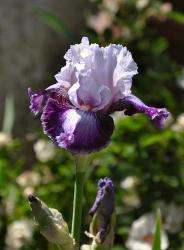
Probably Matt McNames
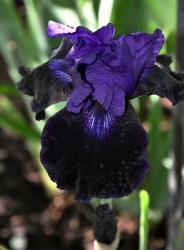
Presumed to be China Dragon

Clarence

At each moment the light changes. And the flowers change. One is lucky on the rare occasions when one is in the garden, the flowers are blooming, and the light is right. The more time I spend photographing the garden, the more surprised I am to get good shots every now and again. It means I have to go out into the garden a lot. And linger. But it's not so bad because some spots smell of apples and honey, a mixture of fragrance from the climbing rose Mme Alfred Carriere and the blue and white iris Clarence.
Mme Alfred Carriere piled atop an arch or two.
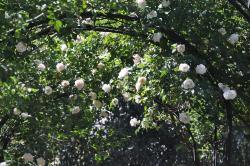
Clarence is well placed, but one of the great problems is that it seems like too many of the iris are simply in the wrong place. There are perfectly lovely iris with pastel flowers crammed up against California poppies which wash out their gentle colors. But once their flowers are gone it's too easy to forget which iris are which. And it's too late to move them. So we're trying the risky thing right now. When an iris is in the wrong place we are moving it: cutting off its flower stalks and a bit of its foliage and placing it in a better location. It's a little scary because the iris sulk in the new locations. Still, the more I think about it the more I know I must address this issue.
Gotta go move some iris...